|
|

A
small tribute to Adolphe Sax
(1814-1894)
|
A brilliant
(and mildly eccentric) Belgian inventor and instrument maker, Sax
has had an impact on the history of musical instrument development
that is rivaled perhaps only by flute innovator Theobald Boehm. After
moving to Paris in his twenties from his native Dinant, Belgium, the
young Sax impressed many notables (including Berlioz, Donizetti, Meyerbeer,
and even French King Louis-Phillippe and Emperor Napoleon II) with
his instruments. 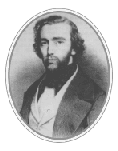
In his lifetime, his bass clarinet and his family of valved bugles
(called saxhorns) were more successful than were the saxophones .
Saxhorns are the direct ancestors of many of today's brass instruments,
including the alto horn (Eb alto saxhorn), baritone horn (Bb tenor
saxhorn), and flugelhorn (Bb soprano saxhorn). The modern tuba is
a German equivalent of Sax's bass/contrabass saxhorn. Though others
had attempted to make a bass clarinet, Sax created the first successful
such instrument by the time he was twenty years old! The modern bass
clarinet has changed very little in basic design from Sax's model.
He also contributed design improvements to the design of the clarinet,
the bassoon, and the timpani, patented the first steam calliope (powered
by a train locomotive!), collaborated with Louis Pasteur on an aromatherapy
box, and patented an improved train whistle. Sax's friend, the renowned
composer and author Hector Berlioz, called Sax "A man of lucid
mind; far-seeing, tenacious, steadfast and skilled beyond words...
He is a calculator, an acoustician, and when required, a smelter,
a turner and, if need be, at the same time an embosser. He can think
and act. He invents, and he accomplishes."
Today, Sax's name
and memory most famously live on in the saxophone family, which was
introduced in Paris in the early 1840's. The saxophone was invented
initially to create a better orchestral bass reed instrument, and
to provide a matched family of wind instruments that would combine
the power of brasses, the agility of woodwinds, the sonority of strings,
the range of a keyboard, and the flexibility of the human voice.
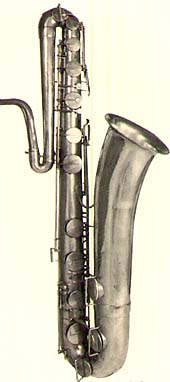
Above
is a bass saxophone (the original type of saxophone)
in
C from the workshop of Adolphe Sax.
The bass saxophone was the first saxophone completed, and it recieved
immediate praise. Berlioz wrote an article in the June 12, 1842 Journal
des Débats describing the new instrument. An excerpt:
"Its sound is of such rare quality that, to my knowledge,
there is not a bass instrument in use nowadays that could be compared
to
the saxophone. It is full, soft, vibrating, extremely powerful, and
easy
to lower in intensity. As far as I am concerned, I find it very superior
to the lower tones of the ophicleide, in accuracy as well as in the
stability of the sound. But the character of its tone is absolutely
new,
and does not resemble any of the timbres heard up till now in our
orchestras with the sole exception of the bass clarinet's lower E
and F.
Owing to its reed, it can increase or diminish the intensity of its
sounds. The notes of the higher compass vibrate so intensively that
they
may be applied with success to melodic expression."
Sadly, the saxophone
was largely shunned by the orchestras of Europe for political reasons,
(the talented Sax had many jealous enemies) but it was accepted with
open arms by military and community bands. In the USA, Sousa and Gilmore's
bands included saxophone sections, which introduced the instrument
to many thousands of people. (For several years Sousa's band reportedly
had a 12-piece sax section that included soprano through contrabass!)
Just prior to the dawn of the recording era, the saxophone was popularized
by vaudeville acts such as the Six Brown Brothers and early virtuosi
like Eduard LeFebre and Rudy Weidoft. There was an explosion in home
sales of saxophones for amateur music makers, and it was inevitable
that this flexible and readily available instrument would soon be
incorporated into the burgeoning jazz scene. In the 1930's and 1940's
widespread interest was reawakened in the instrument's classical potential
in solo and quartet compositions through the performances, commissions,
and teaching of Marcel Mule in France and Sigurd Raschèr in
the USA. The saxophone family's popularity has only grown since, and
we are now witnessing ever-increasing interest in the full range of
the saxophone family, from piccolo through subcontrabass.
Here's the original
patent for the saxophone family- I have inserted comments in Italics:
French
Patent #3226: Saxophone
Descriptive
report deposited in support of a request for a fifteen year patent
of invention. Mr. Antoine-Joseph (called Adolphe) Sax, musical instrument
maker residing in Paris at rue neuve Saint-Georges No. 10 has presented
his patent application at the office of Mr. Perigna, patent attorney,
10 rue neuve St. Augustin, for a new System of wind instruments
called Saxophones.
Explanation
- We know that in general, wind instruments are either too harsh
or too weak in sonority; one or the other of these faults is most
especially perceptible in the basses. The Ophicleide (a bass
keyed bugle- Berlioz uses them to good effect in his Symphonie Fantastique),
for example, which reinforces the trombones, produces a sound
so disagreeable that it must be kept out of resonant halls because
of its inability to be played softly. The bassoon, to the contrary,
has such a feeble sound that it can be used only for accompanying
and filling parts; yet for specific forte effects in orchestration
it is absolutely useless. One should note that the bassoon is the
only instrument of this type which blends well with string instruments.
Only brass wind instruments produce a satisfying effect in outside
performance. Bands comprised of these instruments are the only kind
of ensembles which can be used in these circumstances. Everyone
knows that for outside performance the effect of stringed instruments
is null. Because of the weakness of their timbre, their use is almost
impossible under such conditions. Struck by these different drawbacks,
I have looked for a means of remedying these situations by creating
an instrument, which by the character of its voice can be reconciled
with the stringed instruments, but which possesses more force and
intensity than the strings. This instrument is the Saxophone. The
Saxophone is able to change the volume of its sounds better than
any other instrument. I have made it of brass and in the form of
a parabolic cone to produce the qualities which were just mentioned
and to keep a perfect quality throughout its entire range. The Saxophone
embouchure uses a mouthpiece with a single reed whose interior is
very wide and which becomes narrower at the part which is fitted
to the body of the instrument. (This is in contrast to almost
all mouthpieces in use today, which tend to have wider tip openings
and much more constricted internal dimensions than Sax specified.
This results in greater projection, and a brighter, louder tone.)
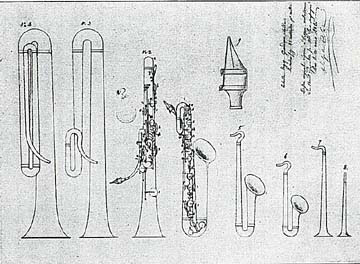
click on drawing for larger version
Description
and nomenclature of the different members of the Saxophone family.
No. 1. Saxophone
in Eb - tenor, fundamental note: B in written pitch is D in concert
pitch. (Now called baritone, usually extended to low written
A. Most saxophones are keyed to low Bb, though many 19th century
instruments were made to low B to reduce expense and weight for
marching.)
No. 2. Saxophone
in C - descending to Bb in its key. The same instrument can also
be made in the key of Bb - it consequently descends to concert Ab
which is Bb in its written key. (This is the bass saxophone-
a few were made in C in the 19th century, but all modern basses
are in Bb.)
No. 3. Contrabass
saxophone in F - it can also be made in Eb. (No contrabass in
F has been built , though Kastner wrote a part for one in his Sextuor
of the mid 1840's)
No. 4. Bourdon
saxophone in C, it can also be made in Bb (one tone lower). (This
subcontrabass saxophone has finally been built by Benedikt Eppelsheim
of Munich. It has a smaller bore than this sketch for more air efficiency,
but has a marvelous tone and is very responsive. It is a larger
version of his Tubax- For details, see the description below, and
visit my subcontrabass saxophone
page.)
The saxophones
No. 5, 6, 7 and 8 are in the same keys as the preceding instruments
at the octave (and fifteenth) higher. (5. is the alto, 6. is
tenor, 7. is sopranino, and 8. soprano.)
No. 9 is
a sketch of a bass saxophone mouthpiece.
This
is a prospectus from a Sax catalogue of 1850.
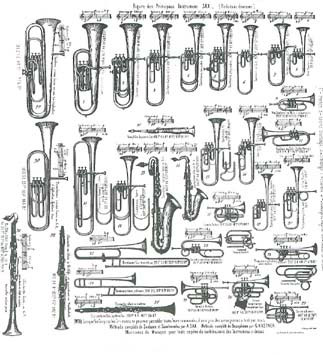
click on drawing for larger version
I
find it interesting that the original patent drawing for the soprano
has a curved neck, a concept which has recently been revived by many
makers. Also,
the original bass saxophone as shown in the patent drawing has a shape
much like an ophicleide,  rather
than the familiar saxophone shape. This also applies to the contrabass
and sub-contra designs, which are rather more efficient and practical
than the current contrabass design. (N.B.- This concept has been lately
revisited by Benedikt Eppelsheim of Munich, Germany - he is now making
a type of contrabass saxophone called Tubax. It has a narrow bore
which in diameter is about like a baritone saxophone, but is twice
as long and wraps around multiple times like a contrabassoon or sarrusophone.
It gains in convenience and ease of response what it may lose in breadth
and warmth of tone. The Tubax has also now been made in C and Bb below
the standard contrabass sax, thus realizing Sax's idea of a "Saxophone
Bourdon.") rather
than the familiar saxophone shape. This also applies to the contrabass
and sub-contra designs, which are rather more efficient and practical
than the current contrabass design. (N.B.- This concept has been lately
revisited by Benedikt Eppelsheim of Munich, Germany - he is now making
a type of contrabass saxophone called Tubax. It has a narrow bore
which in diameter is about like a baritone saxophone, but is twice
as long and wraps around multiple times like a contrabassoon or sarrusophone.
It gains in convenience and ease of response what it may lose in breadth
and warmth of tone. The Tubax has also now been made in C and Bb below
the standard contrabass sax, thus realizing Sax's idea of a "Saxophone
Bourdon.")
At right is
a photo of a 19th-century baritone saxophone which, according to scholar
Robert Howe was made by Pelisson Freres who called it a "Georgeophone".
They were made in Eb baritone and Bb bass models and were intended
for use on horseback, which I find completely delightful.
Below
is a picture of an ophicleide from America's Shrine to Music Museum
in Vermillion, South Dakota.
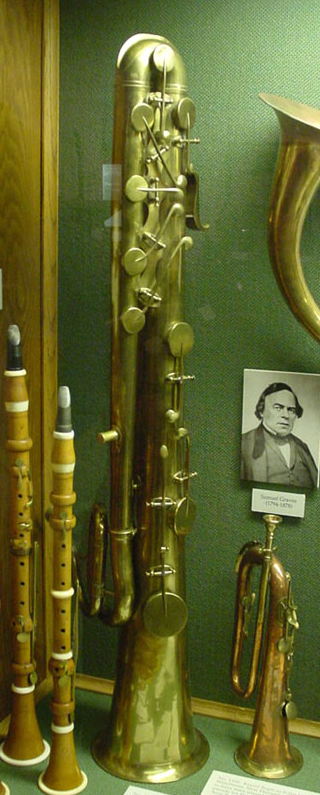
Sax was dedicated
to ensuring the success and lasting survival of his invention, so
much so that after his class as the Paris Conservatoire was cancelled
due to lack of funding because of political upheaval, he offered to
keep teaching for free, despite the fact he was seventy years old
and in dire finacial straits. Sax knew that unless someone trained
performers to use all the saxphones that the family would likely dwindle
to the few already in common use. Sadly, that is exactly what happened,
and only recently have there been signs of renewed interest in the
"other" saxophones. Here are some excerpts from an 1883
letter from a frustrated Mr. Sax to Ambrose Thomas:
"The family of the saxophone does not consist only of the
four types known and popularized by military music. It consists of
up to sixteen members and the professor should accustom his students
to play if not on all of them at least on several types."
"The force of habit is such that saxophonists who refuse to play
another instrument than the one they are used have been able to oppose
the wishes of composers...
" The saxophone in F appeared to me as the true type which should
be adopted for the symphony. Some time ago I had the occasion to play
this instrument separately for two of our young masters, Mr. Massanet
and Mr. Saint-Saëns. They were so impressed by the timbre, the
penetrating charm, and the extraordinary novelty of this orchestral
voice that they at once conceived the project of using it (as Meyerbeer
had done at the beginning of L'Etoil du Nord.) Mr. Massanet introduced
it in one of his symphonic pieces; Mr. Saint-Saëns at once composed
a solo for Henry VIII. However, both composers clashed with the ill-will
or inability of a saxophonist who was used to his saxophone in E-flat,
and both of them were forced to retreat, and entrust their solos to
other instruments; Mr. Massanet to the clarinet, and Mr. Saint-Saëns
to the oboe.
These are the
fruits of blind habit: to be able to deprive the inspiration and inventiveness
of composers of new resources, and to present impassable obstacles."
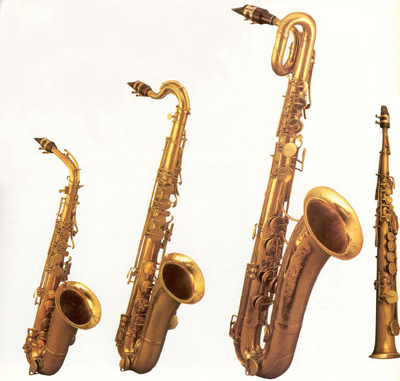
This quartet of saxophones was built in Sax's workshop in the 1860s.
After his death
in 1894, Sax's sons carried on his business. In the 1920's his saxophone
manufacturing operation was sold to the Henri Selmer company. Selmer
has continued to make high quality saxophones to this day.
As Adolphe Sax
conceived of his instruments in famililes, here is a sound sample
of a full classical saxophone ensemble In tribute to this ideal:
mp3 San Diego Sax Orchestra: Portals (Carl Anton Wirth)
5.5MB
Sax's birthday
is November 6th.
Recommended further reading:
- Adolphe
Sax-His Life and Legacy-- Wally Horwood
- Celebrating
the Saxophone-- Paul Lindermeyer
- The
Cambridge Companion to the Saxophone-- ed. Richard Ingham
- The
Early History of the Saxophone--Fred Hemke, DMA dissertation
- Woodwind
Instruments and Their History-- Anthony Baines
This
essay © Jay Easton
Back
|






 rather
than the familiar saxophone shape. This also applies to the contrabass
and sub-contra designs, which are rather more efficient and practical
than the current contrabass design. (N.B.- This concept has been lately
revisited by Benedikt Eppelsheim of Munich, Germany - he is now making
a type of contrabass saxophone called Tubax. It has a narrow bore
which in diameter is about like a baritone saxophone, but is twice
as long and wraps around multiple times like a contrabassoon or sarrusophone.
It gains in convenience and ease of response what it may lose in breadth
and warmth of tone. The Tubax has also now been made in C and Bb below
the standard contrabass sax, thus realizing Sax's idea of a "Saxophone
Bourdon.")
rather
than the familiar saxophone shape. This also applies to the contrabass
and sub-contra designs, which are rather more efficient and practical
than the current contrabass design. (N.B.- This concept has been lately
revisited by Benedikt Eppelsheim of Munich, Germany - he is now making
a type of contrabass saxophone called Tubax. It has a narrow bore
which in diameter is about like a baritone saxophone, but is twice
as long and wraps around multiple times like a contrabassoon or sarrusophone.
It gains in convenience and ease of response what it may lose in breadth
and warmth of tone. The Tubax has also now been made in C and Bb below
the standard contrabass sax, thus realizing Sax's idea of a "Saxophone
Bourdon.")
